第六章 三元相图剖析
- 格式:ppt
- 大小:12.56 MB
- 文档页数:5
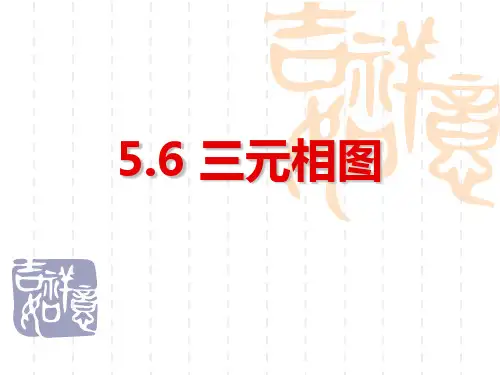

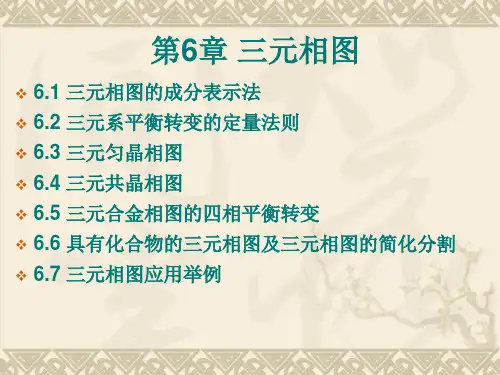
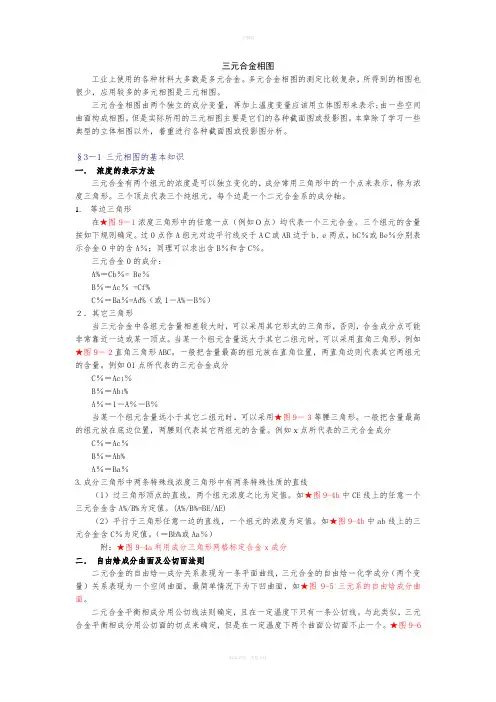
三元合金相图工业上使用的各种材料大多数是多元合金。
多元合金相图的测定比较复杂,所得到的相图也很少,应用较多的多元相图是三元相图。
三元合金相图由两个独立的成分变量,再加上温度变量应该用立体图形来表示;由一些空间曲面构成相图。
但是实际所用的三元相图主要是它们的各种截面图或投影图。
本章除了学习一些典型的立体相图以外,着重进行各种截面图或投影图分析。
§3-1 三元相图的基本知识一.浓度的表示方法三元合金有两个组元的浓度是可以独立变化的,成分常用三角形中的一个点来表示,称为浓度三角形。
三个顶点代表三个纯组元,每个边是一个二元合金系的成分轴。
1.等边三角形在★图9-1浓度三角形中的任意一点(例如O点)均代表一个三元合金。
三个组元的含量按如下规则确定。
过0点作A组元对边平行线交于AC或AB边于b、e两点,bC%或Be%分别表示合金0中的含A%;同理可以求出含B%和含C%。
三元合金0的成分:A%=Cb%= Be%B%=Ac% =Cf%C%=Ba%=Ad%(或1-A%-B%)2.其它三角形当三元合金中各组元含量相差较大时,可以采用其它形式的三角形,否则,合金成分点可能非常靠近一边或某一顶点。
当某一个组元含量远大于其它二组元时,可以采用直角三角形,例如★图9-2直角三角形ABC。
一般把含量最高的组元放在直角位置,两直角边则代表其它两组元的含量。
例如01点所代表的三元合金成分C%=Ac1%B%=Ab1%A%=1-A%-B%当某一个组元含量远小于其它二组元时,可以采用★图9-3等腰三角形。
一般把含量最高的组元放在底边位置,两腰则代表其它两组元的含量。
例如x点所代表的三元合金成分C%=Ac%B%=Ab%A%=Ba%3.成分三角形中两条特殊线浓度三角形中有两条特殊性质的直线(1)过三角形顶点的直线,两个组元浓度之比为定值。
如★图9-4b中CE线上的任意一个三元合金含A%/B%为定值。
(A%/B%=BE/AE)(2)平行于三角形任意一边的直线,一个组元的浓度为定值。



浓度三角形的基本性质①等含量规则:平行于一边的直线上所有点,表示这个边对应顶点的组元含量均相等;②等比例规则:过一顶点的直线上所有点,表示另两个顶点代表的两组元的含量比为一定值。
③背向规则:过一组元的直线上所有的点,离该组元越远,该组元越少,而其他两组元成分比例不变。
直线法则、杠杆定律及重心法则(1)杠杆定律及直线法则:当两个组成已知的相转变成一个新相时,则新相的组成点必在两个原始相组成点的连线上,且位于两点之间,两个原始相的质量之比与它们的组成点到新相组成点之间的距离成反比,称为三元系统的杠杆规则;反之,一个相在一定温度下转变为两个相时也成立。
推论当给定合金在一定温度下处于两相平衡时,若其中一相的成分给定,另一相的成分点必在已知相成分点与合金成分点连线的延长线上;若两平衡相的成分点已知,合金的成分点必然位于两个已知成分点的连线上。
(2) 重心法则把M、N、Q三相混合,要得到新相点P,可采用下述方法:根据杠杆规则先将M和N混合成S,S相的组成点必定在MN连线上,且在M和N之间,具体位置要根据M、N的相对含量而定;接着把S和Q混合得到P相。
即M+N=S,S+Q=P。
综合两式,所以M+N+Q=P表明P相可以通过M、N、Q三相合成而得。
反之,从P相可以分解出M、N、Q三相。
P 点所处的这种位置称为重心位置。
重心法则外推组元在固态互不相溶的共晶相图(1)相图分析面:液相面:3个两元共晶面:6个三元共晶面:1个区:单相区:4个两相区:3个三相区:4个四相区:1个三相共晶平衡区的三元相相图分析:线:三条单变量曲线液相面交线两相共晶线面:2个液相面3个固相面2个固溶面2个三相共晶面区:3个单相区3个两相区1个三相区a:A+C为溶剂B为溶质的固溶体;b:B为溶剂A+C为溶质的固溶体投影图分析各线、面、区在投影图中的位置相图分析:线:三条单变量曲线液相面交线两相共晶线面:2个液相面3个固相面2个固溶面2个三相共晶面区:3个单相区3个两相区1个三相区共晶型与包晶型反应两类三相区的比较共晶型反应三相区 包晶型反应三相区 水平截面图直边三角形 倒立 正立垂直截面图曲边三角形 正立倒立上或下顶点与液相区相连接侧顶点与液相区相连接相区接触法则相数差接触类型 实例 1面接触 2or0线接触 3点接触从占有空间的角度看,固态有限互溶三元共晶相图比固态完全不互溶三元共晶相图要多三个单相区(a,b,g)和三个固态两相区(a+b,b+g,g+a),请见下表:相图分析:线:3条两相共晶线面:3个液相面3个固相面6个两相共晶开始面3个两相共晶结束面3个两相共析面(两相固溶面)相图分析:线:3条两相共晶线Ee1 、Ee2 、Ee3面:3个液相面ae1Ee3a 、be2Ee2b 、ce3Ee2c3个固相面almfa 、bgnhb 、ckpic6个两相共晶开始面(α+β)feEmf 、ge1Eng (β+γ)he2Enh、ie2Epi(γ+α)le3Eml、ke3Epk3个两相共晶结束面fmngf 、hnpih 、qmpli3个两相共析面(两相固溶面)mm'n'nm 、nn'p'pn 、mm'p'pm6个单相析出面(单相固溶面)(α→γII ) ll'm'ml (α→βII ) ff'm'mf(β→αII ) gg'nn'g (β→γII ) hnn'h'h(γ→αII ) kk'p'pk (γ→βII ) ii'p'pi1个3相共晶面以材料O为例,冷却到液相面,开始凝固出初晶a,其成分点位于与液相面Ae1Ee3共轭的固相面Afml上,但需用连相线来确定。
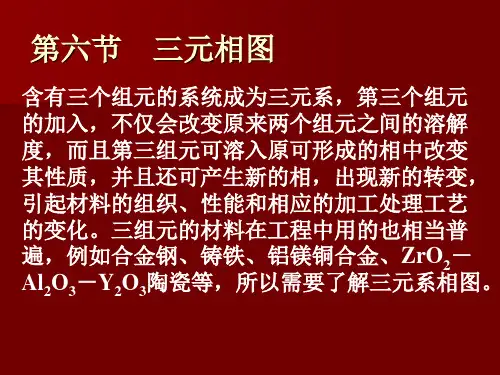
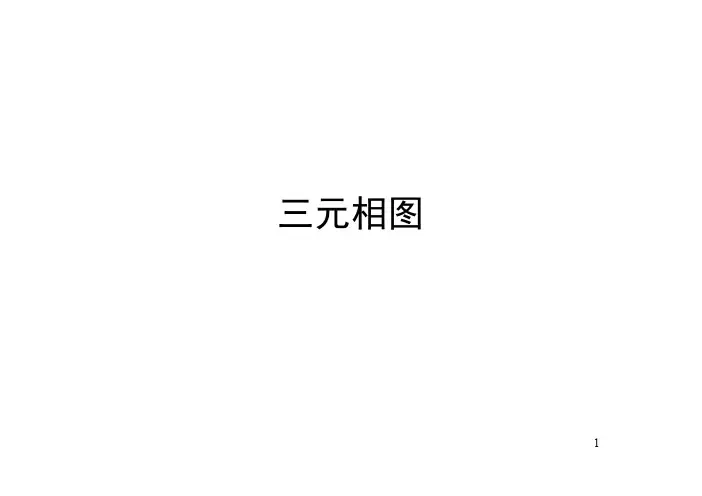

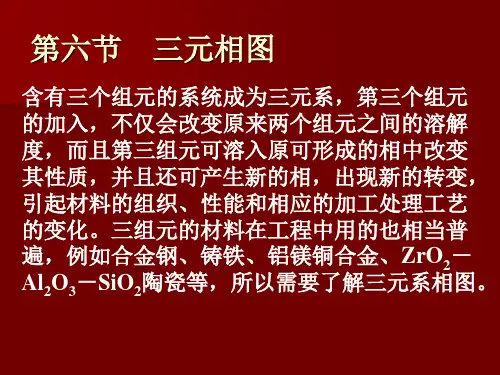
第六章三元相图Chapter 6 Ternary Phase Diagram本章基本问题:1. 三元合金相图的几何原理。
2.直线定律与重心法则的应用。
3.三元匀晶相图和三元共晶相图。
4.立体图在浓度三角形上的投影图、水平截面图和垂直截面图。
5.三元合金相图的分析方法。
6.三元合金结晶过程中相与组织的转变规律。
7.实用三元合金相图进行分析。
Questions for chapter 61. What is the representation of ternary phase diagram?2. How to apply the lever rule and a tie triangle to compute the fractions of phases presentat equilibrium?3. How to understand ternary isomorphous phase diagram and ternary eutectic phasediagram?4. How to draw the projection of 3-D ternary phase diagrams on to the base and how todraw the horizontal sections and vertical sections?5 . How to analyze a ternary phase diagram?6. What are phase transformation rules for ternary alloys?7. How to analyze a real ternary phase diagram?When three components are mixed together to make a ternary alloy we need a three-dimensional space in which to construct the phase diagram, since there are two independent concentration variables and one temperature variable (ignoring pressure as a variable).6-1 三元合金相图的几何原理Sec. 6.1 Representation of the phase diagramTo represent compositions of ternary alloys we need a two-dimensional figure in place of the unit line. A triangle has the necessary property. For convenience we use an equilateral triangle. The three corners represent the pure components A, B and C. The three sides, each of unit length, represent the three binary systems AB, BC and CA. Points inside the triangle represent ternary alloys.We notice two useful features of this representation:(1) Points on a line parallel to a side of the triangle represent alloys with a fixedcontent of the component in the opposite corner;(2) Points on a straight line through one corner represent alloys in which the components at the other two corners are in constant proportions .With the triangle as base we plot temperature vertically, to form a triangular prism. Since the ternary system must merge smoothly into each of the corresponding binaries as one or other of the three components is reduced to zero, the three binary phase diagrams are constructed on the three sides of this triangular prism. This is the framework in which we construct the ternary phase diagram.A convenient way of showing the phases formed in ternary systems is by means of horizontal sections through the phase diagram at various selected temperatures. From such a section we can find the compositions and proportions of the phases present in any alloy in equilibrium at the temperature concerned.Vertical sectionsAnother convenient way of analyzing the solidification of a ternary alloy is by means of vertical sections taken through the phase diagrams. The intersections with the primary, secondary and tertiary surfaces are clearly seen. The disadvantage here however is that we cannot deduce, from such a section, the compositions of the phases present.It is sometimes convenient to take vertical sections along lines through the corners of the phase diagram, since these contain the straight isothermal lines of the secondary stage of freezing.1 三元相图的主要特点(1) 是立体图形,主要由曲面构成;(2) 可发生四相平衡转变;(3) 一、二、三相区为一空间。
材料科学基础第 6 章6.4.6生成一个不一致熔融二元化合物的三元系统相图具有一个不一致熔融二元化合物不一致熔融二元化合物 S 组成点 S(AB n)在AB边上m初晶区SS组成点不在初晶区内有缘学习更多驾卫星ygd3076或关注桃报:奉献教育(店铺)2个三元无变量5条界线4个初晶区连接CS不能划分分系统S(A m B n)E 点低共熔相图局部放大组成点在B初晶区开始析出的晶相为B 组成点在 BSC内结晶结束点 P点析晶产物 B+S+C液相点固相点组成点在B初晶区开始析出的晶相为B组成点在 ASC内结晶结束点 E点析晶产物 C+S+A 液相点固相点组成点在B初晶区开始析出的晶相为B 组成点在 ASC内结晶结束点 E点析晶产物 C+S+A 液相点固相点穿相区:固相组成点移动到S时,从转熔线Pp开始组成点在S的初晶区开始析出的晶相为S 组成点在 ASC内结晶结束点 E点析晶产物 S+A+C液相点固相点析晶结束点是熔体组成点所在副∆相应的无变量点,与其是否在∆内无关。
低共熔点一定是析晶结束点,转熔点可以是析晶结束点,也可不是。
组成在△BSC内(1点)L先消失,B有剩余,析晶过程在P点结束,析晶产物B、S、C三种晶体。
组成在△PSC内(2点)B先消失,L有剩余,转熔结束,析晶未结束,L组成点继续沿界线降低温度,析出晶体。
组成在CS连线上L和B同时消失,转熔过程与结晶过程同时结束, 产物S、C两种晶体。
组成点在PpS区域内(3点)转熔线上的析晶过程,回吸的晶相被回吸完时会出现“穿相区”。